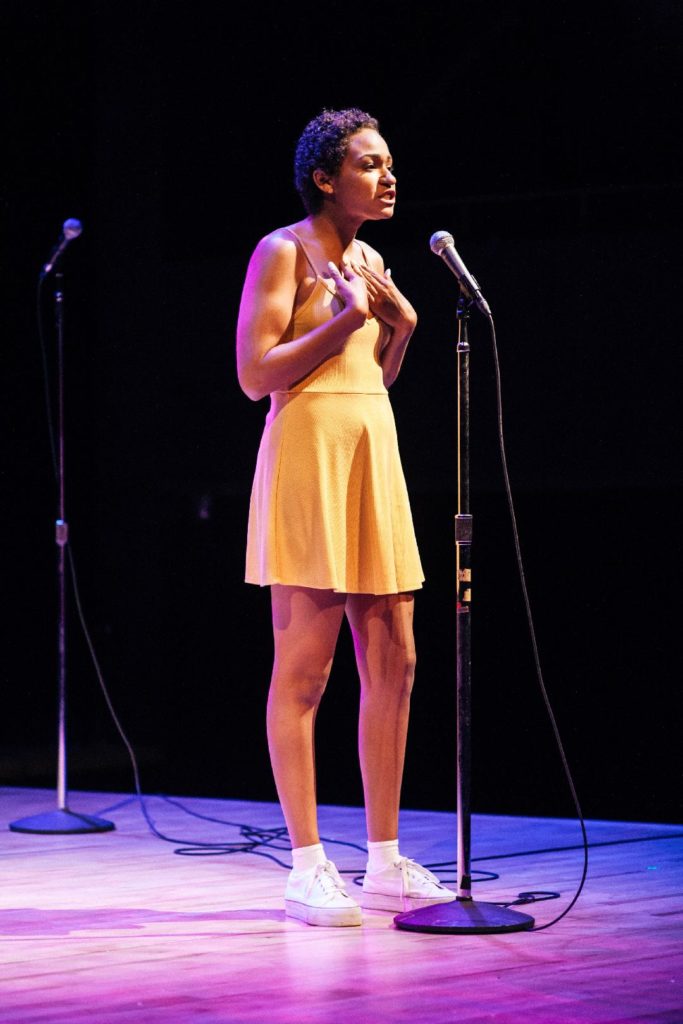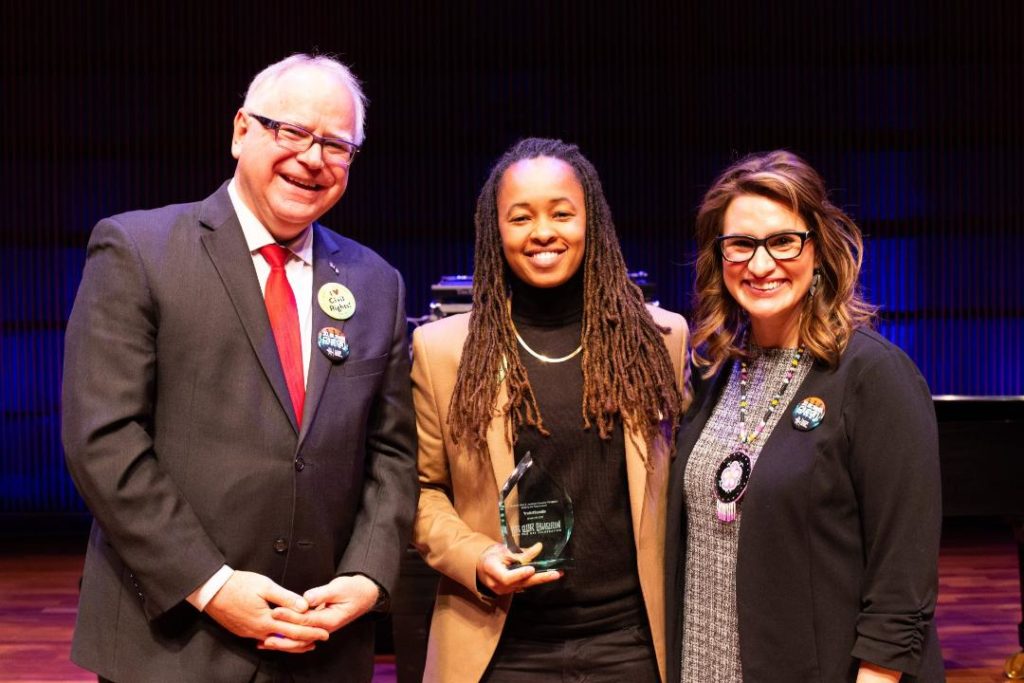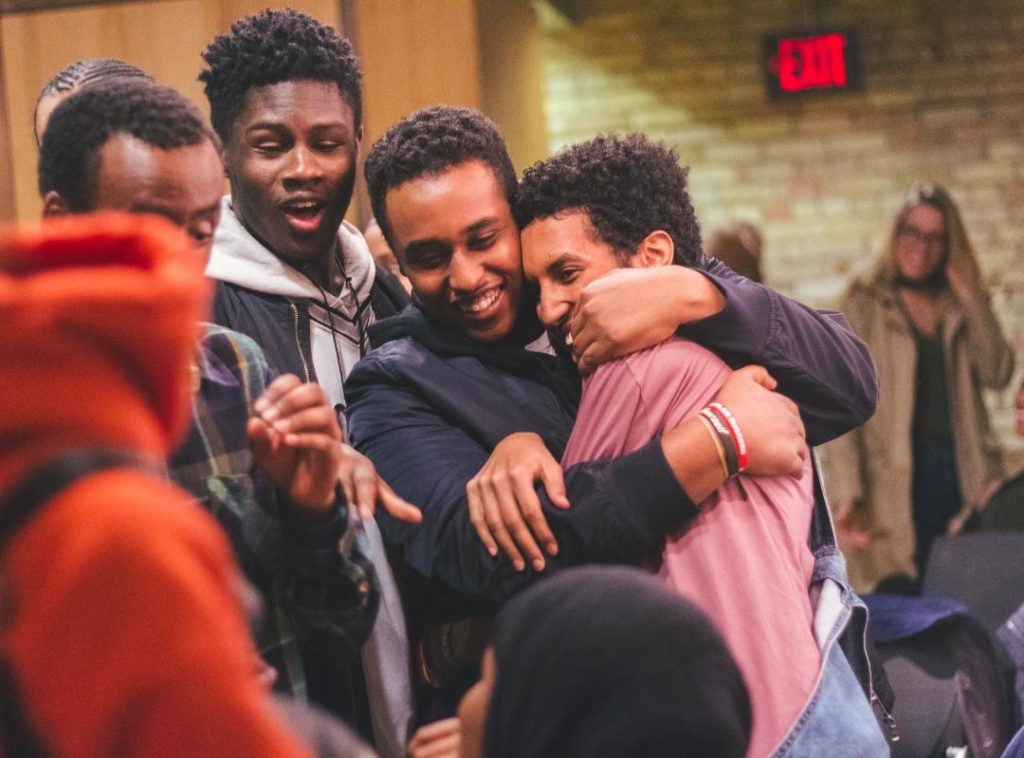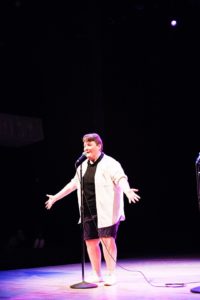TruArtSpeaks the power of poetry for youth empowerment
Tish Jones has been a poet for as long as she can remember. The performer, organizer, and educator from St. Paul is also the founder and executive director of TruArtSpeaks, an organization that uses hip-hip and spoken word as tools for education and social justice, working with youth to cultivate literacy and leadership.
TruArtSpeaks started in 2006 as a collective of artists who were creating hip-hop-centric art in response to different issues they saw in their own communities, as well as those impacting their state, our nation, and the global community. In 2013, the organization took on a nonprofit structure with a fiscal sponsor and a focus on youth education, engagement, and empowerment.
“It’s really about creating an opportunity for young people to have a consistent space in the Twin Cities and in Minnesota to share their voices and really think about how to critically engage with their experiences with craft,” she says. “[This is a space for them to] have radical mentorship in their desire to share and activate their voices to effect some sort of positive social transformation. We provide consistent, safer, more sustainable spaces where kids have access to one another, long-time mentors, and high-quality arts experiences.”

The Be Heard MN Youth Poetry Slam Series is the organization’s biggest program. In previous years, Be Heard was designed as a statewide competition that identified six young people ages 13-19 to represent the state of Minnesota at the international Brave New Voices youth poetry slam festival powered by Youth Speaks.
TruArtSpeaks has taken a bit of a pivot with this program this year, Jones explains, as the festival is no longer mission-aligned with that of TruArtSpeaks. Starting with this year’s Be Heard program, TruArtSpeaks will identify six young poets to be mentored over the course of a year, during which time these individuals will produce their own manuscripts, learn how to shop poems to journals and other literary publications, and also learn “how to embark on the journey that is establishing a relationship with different publishers and pitch to competitions.” The six selected poets will also receive a small stipend towards continuing their education.
“It’s our intention to help these young people find their voices; develop their voices; and study, shape, and apply their voices here with radical, intentional mentorship,” says Jones. The long-established program is well known in the local hip-hop and poetry communities. Many of the youth participants come to it by word of mouth through the program’s established reputation, but Jones says they also have radio and media partnerships, promote it through social media, and also do outreach work in schools, shelters, and community centers.

Be Heard was initially created as a way to support young poets in their interest in attending the Brave New Voices festival, which Jones also directed at the time. Some of the kids they were working with at TruArtSpeaks asked them to create this program, which prompted them to formalize the organization and its programs, in turn taking on more of an education and development structure.
“At that time it was an intentional changeover to create more opportunities for young people,” Jones explains. “We were asked by a lot of youth in the community to take on that program, so TruArtSpeaks went from us being a crew who got together [with the intention of] making a name for our arts practices and holding some community events, to a more formal institution that had more of a youth and community focus. As practicing artists, we were artists making space for art, but we weren’t doing a ton of youth development prior to that.”
The grand slam finals for this year’s Be Heard MN Youth Poetry Slam Series will be held March 28th at SteppingStone Theatre for Youth at 7 p.m. Jones encourages people to come out and participate as audience members to support these young poets.
“One of the most important things in the work I do is providing young people with an audience,” she says. “To be an audience member is not a passive thing. It is to bear witness. It’s very important for those young people to have an audience. It’s very important for these young folks to have folks bear witness and have them actively participate and be an agent to their story, to listen and carry these stories with them. We really invite, encourage, and urge people to come out and listen to this next generation and let them know we support them; let them know they’re the next emerging artists.”

TruArtSpeaks has several other youth development programs in addition to Be Heard, but Jones calls their Reverb Open Mic program “the most important.”
The weekly open mic event is held at the Hallie Q. Brown Community Center every Thursday from 7-9 p.m. This free event is open to all ages.
“To me, it’s the most important program at TruArtSpeaks,” says Jones. “It’s the step folks take before they sort of come into themselves. You come into that space to bear witness to the process of creating art. It’s structured to be a dialogical space in which community is built, ideas are challenged, and craft in the world is explored. This event has been a catalyst in many people’s careers in one way or another.”
 Reverb Open Mic started in 2011, and over the past decade it has become something of an incubator space for Twin Cities poets and other artists, a stepping stone in the careers of many who have gone on to find larger audiences across the country.
Reverb Open Mic started in 2011, and over the past decade it has become something of an incubator space for Twin Cities poets and other artists, a stepping stone in the careers of many who have gone on to find larger audiences across the country.
“It’s such an important space, and not just for getting ‘famous,'” she says. “We look at this space as a juvenile detention alternative space. During prime hours, that two-hour time block at night, these kids could be doing anything in the world, but they’re at this open mic.”
TruArtSpeaks also partners with different detention and correctional facilities and shelters to bus kids in to take part in the program.
“That space becomes home for these young people,” says Jones. “It’s where I go to feel to grounded. It’s also one of the greatest examples of our pedagogy in action: they start as witnesses, then become program participants, then leaders. The idea is that after engaging them [through this program] they will move on into the arts ecosystem here [in St. Paul]. This program is a great example of that.”
Jones is still a practicing poet herself independent of TruArtSpeaks. She performs nationally and internationally in addition to being an educator, organizer, and public speaker. She convenes and creates space for other folks to practice and witness craft, and thinks about cultural strategies centered around liberation. As a 2019/20 Springboard for the Arts’ 20/20 Artist Fellow, Jones has been thinking more about space making and space keeping, specifically in regard to having places for Black folks in the Twin Cities and Minnesota.
“I’ve been studying different models throughout the country from mentors of mine and experts who have kept Black spaces as areas have been gentrified, and how to make Black space in the community so that Black folks can have access to different kinds of spaces—maker spaces, spaces for fellowship, and spaces to exist safely. With this fellowship I’ve really been studying those things and working to develop, make, and keep space for Black folks here in the Twin Cities.”
She is looking into purchasing and developing a physical space, and is working with the city on identifying possible spaces and determining the level of support the city can offer for such spaces in various communities. She is still in the research stage, having meetings with people in different sectors, but describes her vision for a “multi-purpose, cultural destination space for Black folks in the Twin Cities.”
“People have been using different models, like co-op models or different community members donating space or gifting large assets to various entities, so that’s what this research is about,” she says. “There are a lot of different ways in which the process has been successful in different communities, so I’m exploring what could work right now.”
All photos courtesy of Tish Jones.
Applications for the 2020 20/20 Artist Fellowship for BIPOC (Black, Indigenous, People of Color) and Native artists of all practices, disciplines, and career stages residing or working in Minnesota will open later this month. Check the website for complete details.

(1) How do you like to collaborate?
The first step in all of my collaborations is to evaluate our shared values. That’s key.
(2) How do you start a project?
It varies. Some projects begin with passion, others research, others a moment of inspiration, others are based on community need/response.
(3) How do you talk about your value?
Oftentimes I don’t, to be honest. I do so much work with others that I tend to let the work speak for itself or simply share products that result from the work.
(4) How do you define success?
If the community that I serve experiences joy, comes to find their voice, walks away with a positive additive to their lives—that is success for me. Along with positive social transformation.
(5) How do you fund your work?
In the most recent years, I have been funding my work personally. I have also received a great amount of commissions in the last few years. Historically (and in a future-focused sense) I have received some philanthropic support.
